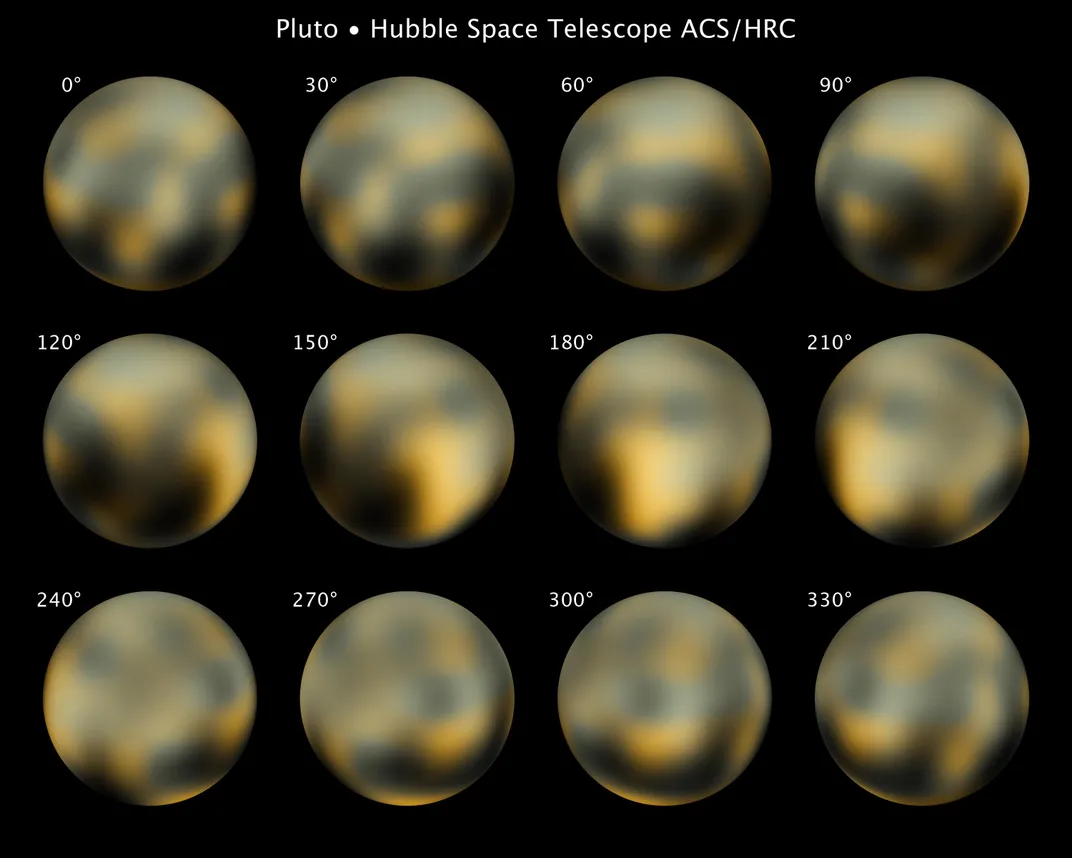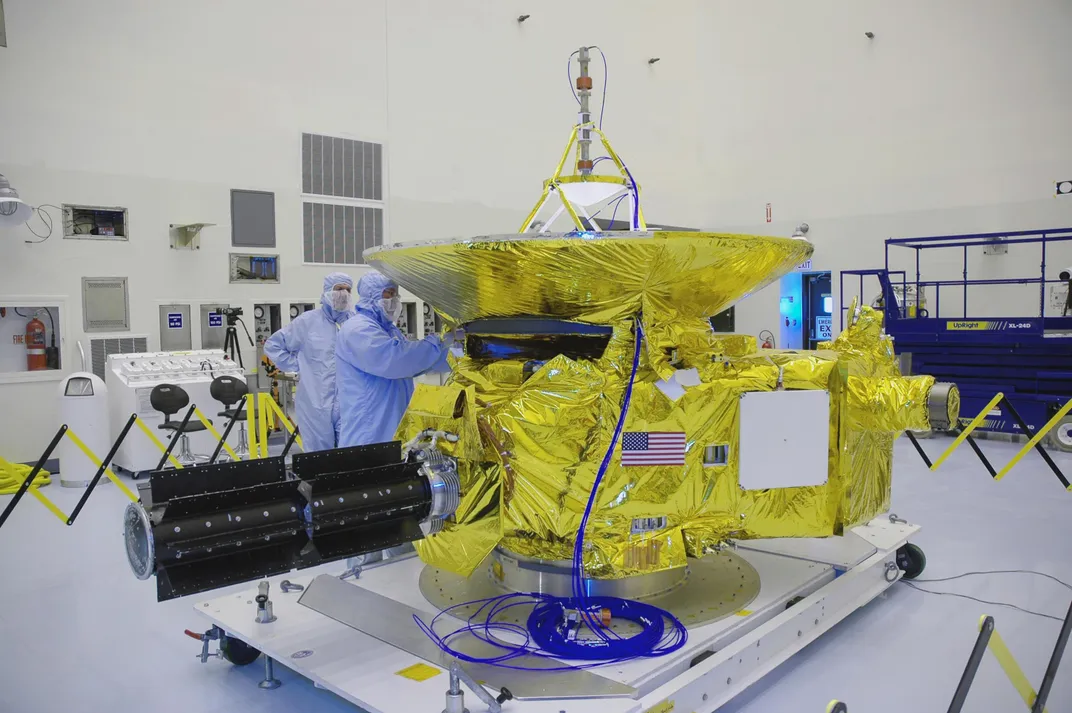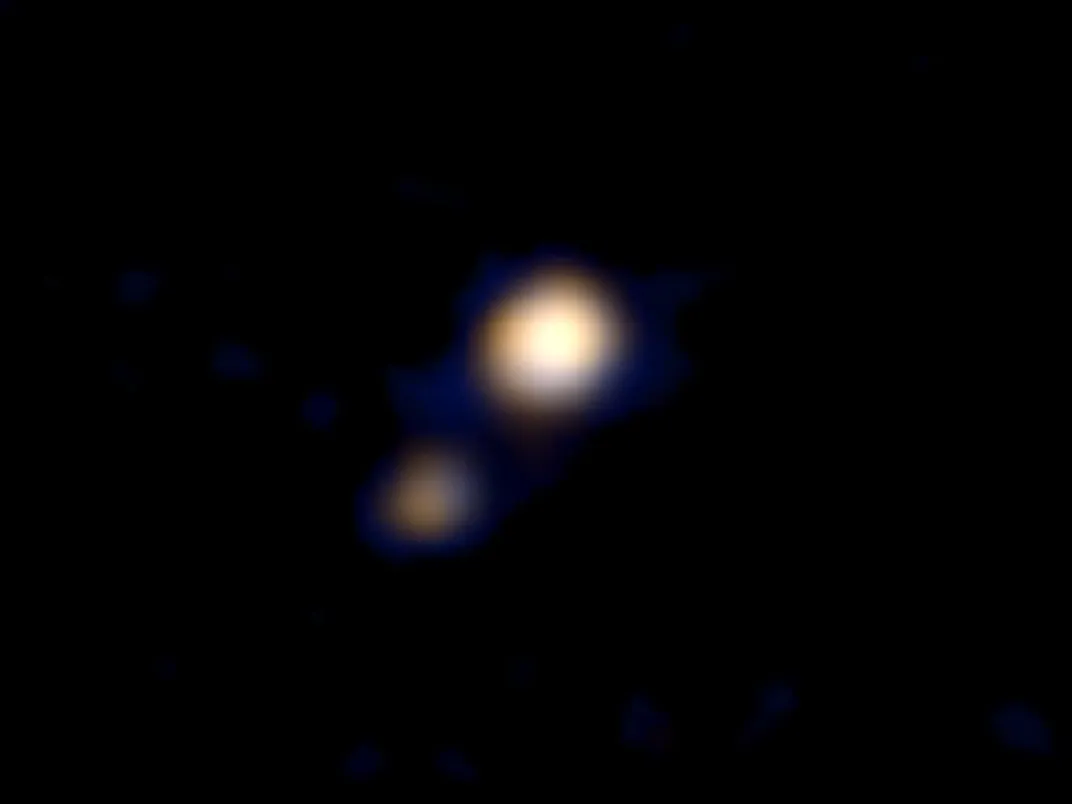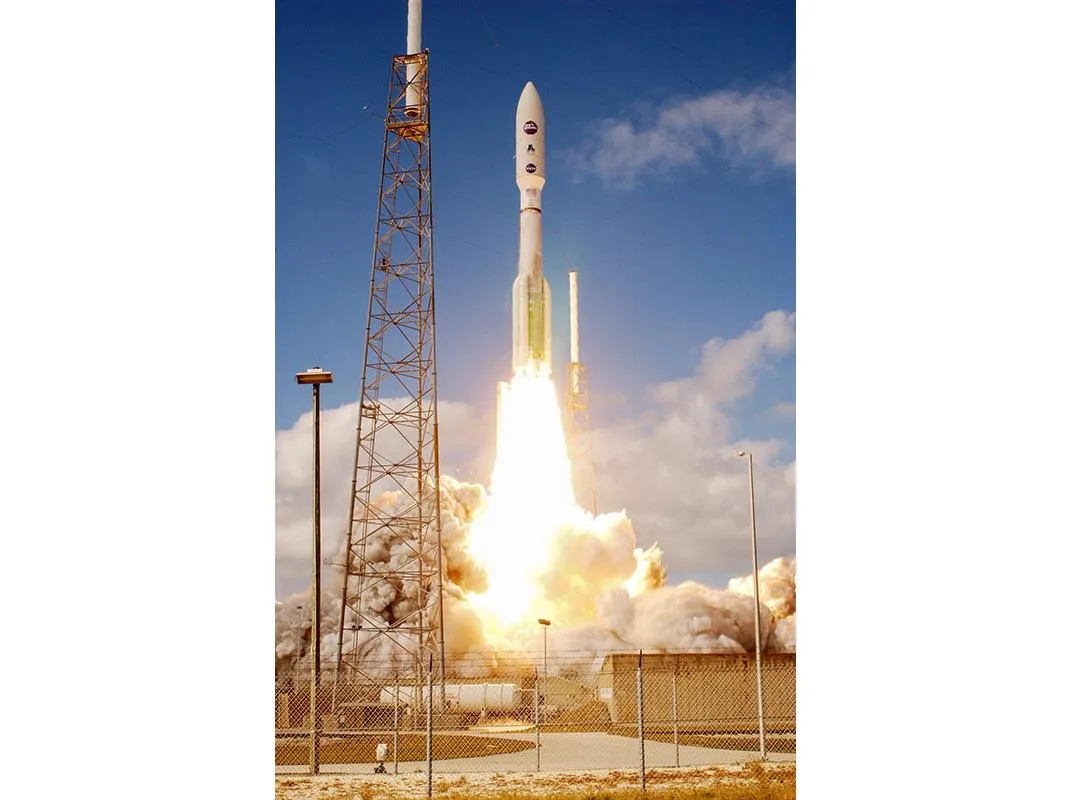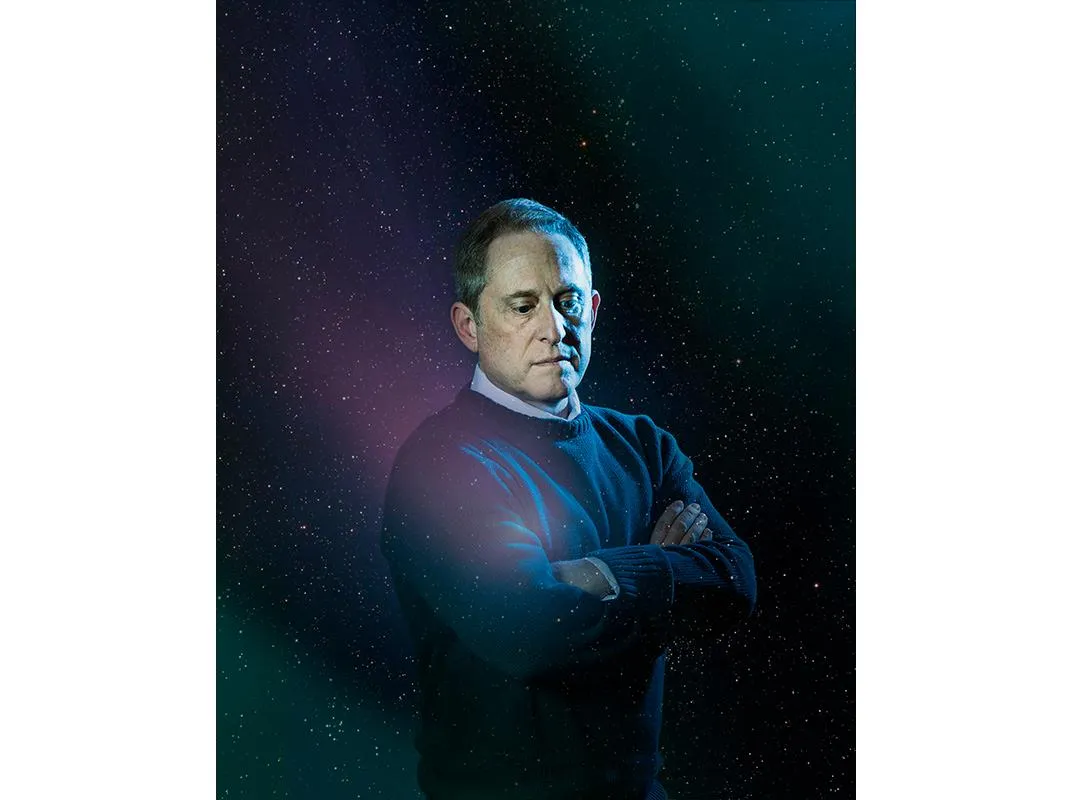One Man’s Lifelong Pursuit of Pluto is About to Get Real
When the New Horizons spacecraft races by the quasi-planetary body, Alan Stern will have finally met his match
/https://tf-cmsv2-smithsonianmag-media.s3.amazonaws.com/filer/9a/91/9a915e4d-0f04-4070-a23a-14acbf3351ed/jun2015_g01_pluto.jpg)
On July 14 at approximately 8 a.m. Eastern time, a half-ton NASA spacecraft that has been racing across the solar system for nine and a half years will finally catch up with tiny Pluto, at three billion miles from the Sun the most distant object that anyone or anything from Earth has ever visited. Invisible to the naked eye, Pluto wasn’t even discovered until 1930, and has been regarded as our solar system’s oddball ever since, completely different from the rocky planets close to the Sun, Earth included, and equally unlike the outer gas giants. This quirky and mysterious little world will swing into dramatic view as the New Horizons spacecraft makes its closest approach, just 6,000 miles away, and onboard cameras snap thousands of photographs. Other instruments will gauge Pluto’s topography, surface and atmospheric chemistry, temperature, magnetic field and more. New Horizons will also take a hard look at Pluto’s five known moons, including Charon, the largest. It might even find other moons, and maybe a ring or two.
It was barely 20 years ago when scientists first learned that Pluto, far from alone at the edge of the solar system, was just one in a vast swarm of small frozen bodies in wide, wide orbit around the Sun, like a ring of debris left at the outskirts of a construction zone. That insight, among others, has propelled the New Horizons mission. Understand Pluto and how it fits in with those remnant bodies, scientists say, and you can better understand the formation and evolution of the solar system itself.
If all goes well, “encounter day,” as the New Horizons team calls it, will be a cork-popping celebration of tremendous scientific and engineering prowess—it’s no small feat to fling a collection of precision instruments through the frigid void at speeds up to 47,000 miles an hour to rendezvous nearly a decade later with an icy sphere about half as wide as the United States is broad. The day will also be a sweet vindication for the leader of the mission, Alan Stern. A 57-year-old astronomer, aeronautical engineer, would-be astronaut and self-described “rabble-rouser,” Stern has spent the better part of his career fighting to get Pluto the attention he thinks it deserves. He began pushing NASA to approve a Pluto mission nearly a quarter of a century ago, then watched in frustration as the agency gave the green light to one Pluto probe after another, only to later cancel them. “It was incredibly frustrating,” he says, “like watching Lucy yank the football away from Charlie Brown, over and over.” Finally, Stern recruited other scientists and influential senators to join his lobbying effort, and because underdog Pluto has long been a favorite of children, proponents of the mission savvily enlisted kids to write to Congress, urging that funding for the spacecraft be approved.
New Horizons mission control is headquartered at Johns Hopkins University’s Applied Physics Laboratory near Baltimore, where Stern and several dozen other Plutonians will be installed for weeks around the big July event, but I caught up with Stern late last year in Boulder at the Southwest Research Institute, where he is an associate vice president for research and development. A picture window in his impressive office looks out onto the Rockies, where he often goes to hike and unwind. Trim and athletic at 5-foot-4, he’s also a runner, a sport he pursues with the exactitude of, well, a rocket scientist. He has calculated his stride rate, and says (only half-joking) that he’d be world-class if only his legs were longer. It wouldn’t be an overstatement to say that he is a polarizing figure in the planetary science community; his single-minded pursuit of Pluto has annoyed some colleagues. So has his passionate defense of Pluto in the years since astronomy officials famously demoted it to a “dwarf planet,” giving it the bum’s rush out of the exclusive solar system club, now limited to the eight biggies.
The timing of that insult, which is how Stern and other jilted Pluto-lovers see it, could not have been more dramatic, coming in August 2006, just months after New Horizons had rocketed into space from Cape Canaveral. What makes Pluto’s demotion even more painfully ironic to Stern is that some of the groundbreaking scientific discoveries that he had predicted greatly strengthened his opponents’ arguments, all while opening the door to a new age of planetary science. In fact, Stern himself used the term “dwarf planet” as early as the 1990s.
**********
The wealthy astronomer Percival Lowell, widely known for insisting there were artificial canals on Mars, first started searching for Pluto at his private observatory in Arizona in 1905. Careful study of planetary orbits had suggested that Neptune was not the only object out there exerting a gravitational tug on Uranus, and Lowell set out to find what he dubbed “Planet X.” He died without success, but a young man named Clyde Tombaugh, who had a passion for astronomy though no college education, arrived at the observatory and picked up the search in 1929. After 7,000 hours staring at some 90 million star images, he caught sight of a new planet on his photographic plates in February 1930. The name Pluto, the Roman god of the underworld, was suggested by an 11-year-old British girl named Venetia Burney, who had been discussing the discovery with her grandfather. The name was unanimously adopted by the Lowell Observatory staff in part because the first two letters are Percival Lowell’s initials.
Pluto’s solitary nature baffled scientists for decades. Shouldn’t there be other, similar objects out beyond Neptune? Why did the solar system appear to run out of material so abruptly? “It seemed just weird that the outer solar system would be so empty, while the inner solar system was filled with planets and asteroids,” recalls David Jewitt, a planetary scientist at UCLA. Throughout the decades various astronomers proposed that there were smaller bodies out there, yet unseen. Comets that periodically sweep in to light up the night sky, they speculated, probably hailed from a belt or disk of debris at the solar system’s outer reaches.
Stern, in a paper published in 1991 in the journal Icarus, argued not only that the belt existed, but also that it contained things as big as Pluto. They were simply too far away, and too dim, to be easily seen. His reasoning: Neptune’s moon Triton is a near-twin of Pluto, and probably orbited the Sun before it was captured by Neptune’s gravity. Uranus has a drastically tilted axis of rotation, probably due to a collision eons ago with a Pluto-size object. That made three Pluto-like objects at least, which suggested to Stern there had to be more. The number of planets in the solar system would someday need to be revised upward, he thought. There were probably hundreds, with the majority, including Pluto, best assigned to a subcategory of “dwarf planets.”
Just a year later, the first object (other than Pluto and Charon) was discovered in that faraway region, called the Kuiper Belt after the Dutch-born astronomer Gerard Kuiper. Found by Jewitt and his colleague, Jane Luu, it’s only about 100 miles across, while Pluto spans 1,430 miles. A decade later, Caltech astronomers Mike Brown and Chad Trujillo discovered an object about half the size of Pluto, large enough to be spherical, which they named Quaoar (pronounced “kwa-war” and named for the creator god in the mythology of the pre-Columbian Tongva people native to the Los Angeles basin). It was followed in quick succession by Haumea, and in 2005, Brown’s group found Eris, about the same size as Pluto and also spherical.
Planetary scientists have spotted many hundreds of smaller Kuiper Belt Objects; there could be as many as ten billion that are a mile across or more. Stern will take a more accurate census of their sizes with the cameras on New Horizons. His simple idea is to map and measure Pluto’s and Charon’s craters, which are signs of collisions with other Kuiper Belt Objects and thus serve as a representative sample. When Pluto is closest to the Sun, frozen surface material evaporates into a temporary atmosphere, some of which escapes into space. This “escape erosion” can erase older craters, so Pluto will provide a recent census. Charon, without this erosion, will offer a record that spans cosmic history. In one leading theory, the original, much denser Kuiper Belt would have formed dozens of planets as big or bigger than Earth, but the orbital changes of Jupiter and Saturn flung most of the building blocks away before that could happen, nipping planet formation in the bud.
By the time New Horizons launched at Cape Canaveral on January 19, 2006, it had become difficult to argue that Pluto was materially different from many of its Kuiper Belt neighbors. Curiously, no strict definition of “planet” existed at the time, so some scientists argued that there should be a size cutoff, to avoid making the list of planets too long. If you called Pluto and the other relatively small bodies something else, you’d be left with a nice tidy eight planets—Mercury through Neptune. In 2000, Neil deGrasse Tyson, director of the Hayden Planetarium in New York City, had famously chosen the latter option, leaving Pluto out of a solar system exhibit.
Then, with New Horizons less than 15 percent of the way to Pluto, members of the International Astronomical Union, responsible for naming and classifying celestial objects, voted at a meeting in Prague to make that arrangement official. Pluto and the others were now to be known as dwarf planets, which, in contrast to Stern’s original meaning, were not planets. They were an entirely different sort of beast. Because he discovered Eris, Caltech’s Brown is sometimes blamed for the demotion. He has said he would have been fine with either outcome, but he did title his 2010 memoir How I Killed Pluto and Why It Had It Coming.
“It’s embarrassing,” recalls Stern, who wasn’t in Prague for the vote. “It’s wrong scientifically and it’s wrong pedagogically.” He said the same sort of things publicly at the time, in language that’s unusually blunt in the world of science. Among the dumbest arguments for demoting Pluto and the others, Stern noted, was the idea that having 20 or more planets would be somehow inconvenient. Also ridiculous, he says, is the notion that a dwarf planet isn’t really a planet. “Is a dwarf evergreen not an evergreen?” he asks.
Stern’s barely concealed contempt for what he considers foolishness of the bureaucratic and scientific varieties hasn’t always endeared him to colleagues. One astronomer I asked about Stern replied, “My mother taught me that if you can’t say anything nice about someone, don’t say anything.” Another said, “His last name is ‘Stern.’ That tells you all you need to know.”
DeGrasse Tyson, for his part, offers measured praise: “When it comes to everything from rousing public sentiment in support of astronomy to advocating space science missions to defending Pluto, Alan Stern is always there.”
Stern also inspires less reserved admiration. “Alan is incredibly creative and incredibly energetic,” says Richard Binzel, an MIT planetary scientist who has known Stern since their graduate-school days. “I don’t know where he gets it.”
**********
Stern grew up in New Orleans and later Dallas. His father was a business executive and his mother stayed at home with Alan and his two siblings. “Alan was 100 percent consumed with space travel by the age of 8,” recalls his younger brother Hap, an attorney in Dallas. “He wanted more than anything to be an astronaut.”By the time Stern went to college, in 1975, the Apollo program had ended and the first space shuttle launch was several years away, but after spending an undergraduate year or two as a “slacker”—his word—he began working to become exactly what NASA would expect of its astronaut candidates: an overachiever. “I made straight A’s from that point on,” he says, graduating from the University of Texas at Austin with degrees in physics and astronomy. His extracurriculars, too, were astronaut-friendly: He got his pilot’s license, became a flight instructor
People make vows like this all the time. They’re far easier to make than to keep—especially when your career goal is something as unrealistically romantic as becoming an astronaut. and learned to skydive and scuba dive.
He stayed on at Austin and picked up master’s degrees in aerospace engineering and planetary atmospheres. He took a job as an engineer at the aerospace company Martin Marietta, working on various satellite programs. Then he moved to the Laboratory for Atmospheric and Space Physics at the University of Colorado, in Boulder, where he designed and oversaw an instrument for a satellite intended to study Halley’s Comet during its 1986 visit. That satellite, though, was aboard the space shuttle Challenger when the ship exploded on January 28, 1986, killing its seven-member crew and putting the U.S. human spaceflight program on hiatus.
Stern had become intrigued by comets, and ended up writing a doctoral dissertation on the evolution of those icy bodies, and he devised instruments to study them. His ultraviolet spectrograph would capture light bouncing off a comet’s temporary atmosphere to find out what it was made of. Last year, when the European Space Agency’s Rosetta probe became the first ever to orbit a comet, one of Stern’s UV spectrographs found the surface of the comet surprisingly devoid of water ice.
Given that extraordinary accomplishment, Nothing if not relentless, Stern applied to the astronaut corps three times after the shuttle had started flying again in 1988, and was even selected as one of 130 among thousands of applicants to come to Houston to interview. In the end, he wasn’t chosen. But he hoped he’d get another shot when Comet Hale-Bopp lit up the night sky in 1997. He adapted one of his instruments to ride on the shuttle—and who better to operate it, he was convinced, than Stern himself? NASA threw the decision over to a committee of astronauts, who decided his expertise would be essential, and he was elated to be heading for space at last.
At the last minute, however, NASA put a Canadian astronaut on the flight, bumping Stern off. It bothers him even today to recall his disappointment. “I was very upset because I realized there was no...the time was running out. There was no way that I...it was all done. It was a done deal. It’s the only time in my life I ever cried over something about work,” he says. “I mean I just lost it.”
But it didn’t slow him down. In addition to overseeing missions, and a brief stint as NASA’s associate administrator for science, he co-founded a company called Uwingu, which raises money for astronomy activities by (unofficially) selling the naming rights to exoplanets and craters on Mars. He also co-founded World View, which plans to take tourists to the edge of space in high-altitude balloons, and another company, called Golden Spike, to sell Moon missions to countries that want to go there. And one project could achieve his dream of going into space himself. He and his team at Southwest have designed instruments for suborbital spaceflights planned by the private companies Virgin Galactic and XCOR Aerospace. Scientists will need to run the instruments, and, Stern says, “We’ve bought a total of nine seats,” on separate flights. He is determined to occupy several of them.
**********
There is another cause, however, that obsesses him even more passionately than traveling to space. “Even in grad school,” said Binzel, when I met up with him in Boulder, “Alan was talking to me about it. He’s like Luke Skywalker.” Then, in a spot-on Darth Vader imitation: “Exploring Pluto...is your destiny.”
Planetary scientists have learned only a few things about Pluto since its discovery: They’ve pinned down its 248-year orbit, and close observations of how Pluto and Charon circle each other have yielded their sizes and masses. From these, compositions can be predicted—a mixture of rock and ice. The bulk of the ice on both is frozen water, while the ice coating Pluto’s surface is mostly frozen nitrogen. Surface temperatures hover around minus-380-degrees Fahrenheit.
New Horizons is expected to reveal much more. Visible light cameras will not only count craters, but also map hills, valleys, cliffs and cracks smaller than a football field. Infrared sensors will show variations in surface temperature, perhaps revealing warm spots that suggest geologic activity. One set of instruments will analyze the chemical makeup of the surface, while another, similar to the spectrograph aboard Rosetta, will study the temporary atmosphere.
The list of questions is nearly endless. Does Pluto have an ocean of liquid water beneath its icy surface, for example, like those on the icy moons of Jupiter and Saturn? Does that ocean feed geysers that spray off into space? Why does Pluto have a higher proportion of rock under the ice than Charon?
And then there are the questions the scientists don’t even know enough to be asking. “The big lesson of planetary science,” says Stern, “is when you do a first reconnaissance of a new kind of object, you should expect the unexpected.”
Come encounter day, Stern’s wife, Carole, and their three children, along with parents, siblings, nieces and nephews, and several cousins, will join him at mission headquarters. “I can’t imagine not being there,” says Stern’s youngest daughter, Kate, 24. “It’s like if you’re married and your wife gives birth and you don’t show up.”
Already the spacecraft’s approach is making news. In April, NASA released the first color images of Pluto and Charon from New Horizons. The best photographs are yet to come. Some Pluto lovers have speculated that, in bringing this blurry blob into focus, New Horizons might find a reason to restore its planetary status. It’s a romantic notion, but Stern isn’t convinced. He is focused instead on the details of the encounter, on the data already streaming in and on a new understanding of an object that has captivated his attention for more than two decades, and mystified the world for eight and a half. “It says something very deep about humans and our society, something very good about us, that we’ve invested our time and treasure in building a machine that can fly across three billion miles of space to explore the Pluto system. But,” he continues, “it makes it hard to celebrate and appreciate that accomplishment in the context of a constant discussion about the demotion of Pluto.”
Related Reads
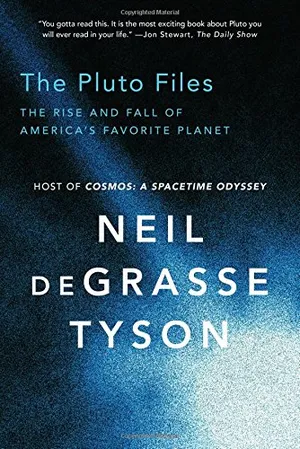
The Pluto Files: The Rise and Fall of America's Favorite Planet
